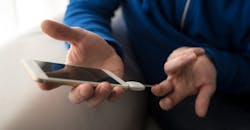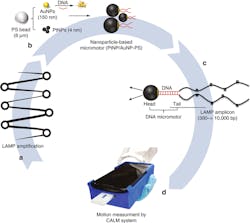Turning Your Everyday Smartphone into an HIV Detection Tool
According to CDC estimates, 1.8 million new cases of HIV were diagnosed worldwide in 2017. In the United States alone, 38,739 individuals received an HIV diagnosis; Sub-Saharan Africa contains the largest percentage of new HIV patients, at 66%. Testing for HIV early is crucial for treatment but also difficult. In some developing countries, false testing results may occur due to the use of highly sensitive rapid diagnostic tests as the first test within a national testing algorithm. Many HIV positive diagnoses are made following a series of multiple tests.
Among the efforts to battle HIV’s spread, Investigators from Brigham and Women’s Hospital have designed a portable and affordable mobile device diagnostic tool—one with the ability to detect the virus and monitor its management in resource-limited regions. The diagnostic tool uses an everyday cellphone and nanotechnology to detect the virus.
Hadi Shafiee is the principal investigator in Brigham’s Division of Engineering in Medicine and Renal Division of Medicine. He is the senior author of the team’s most recent paper, “DNA Engineered Micromotors Powered by Metal Nanoparticles for Motion Based Cellphone Diagnostics.” “Early detection of HIV is critical to prevent disease progression and transmission,” it noted, “and it requires long-term monitoring, which can be a burden for families that have to travel to reach a clinic or hospital. This rapid and low-cost cellphone system represents a new method for detecting acute infection, which would reduce the risk of virus transmission and could also be used to detect early treatment failure.”
Schematic presentation of HIV-1 detection using the cellphone system. The developed system integrates cellphone-based optical sensing, loop-mediated isothermal amplification, and micromotor motion (CALM). a.) A loop-mediated isothermal amplification (LAMP) reaction is performed to amplify the nucleic acid of HIV-1 and large-size looped amplicons; b.) the formed amplicons are mixed with DNA-modified micromotors that are specifically designed using 6-μm polystyrene (PS) beads covered with a hybrid surface layer of platinum (Pt) and gold (Au) nanoparticles to power the catalytic motion of motors in the presence of hydrogen peroxide; c.) the capture of LAMP amplicons on the surface of motors results in the formation of motile assemblies with a catalytic head of motors and large tail of DNA; d.) The motion of these assemblies can be detected and measured using a cellphone system on-chip for qualitative HIV-1 detection. (Credit: Nature Communications)
The device works by using nanotechnology, a microchip, a cellphone, and a 3D-printed phone attachment that can detect RNA nucleic acids of the virus from just one drop of blood. The device detects the amplified HIV nucleic acids through the on-phone motion monitoring system. It does so without the need for bulky or expensive equipment.
The researchers found that their platform’s accuracy was within 99.1% specificity and 94.6% sensitivity at the clinically relevant threshold value of 1,000 virus particles/mL. The HIV test results through this method are ready within one hour. The most important aspect is that the total cost of the microchip, phone attachment, and reagents was less than $5 per test.
The benefits of this test are immensely valuable. First health workers in developing countries can use this device to quickly and accurately diagnosis HIV and help alleviate the mistakes of misdiagnosis. “Because the test is so quick, critical decisions about the next medical step could be made right there,” said Shafiee. “This would eliminate the burden of trips to the medical clinic and provide individuals with a more efficient means for managing their HIV.”
Thinking beyond the HIV virus, the same method can be used to identify the presence of other illnesses, providing fast and cheap detection methods for other viruses and bacteria.


